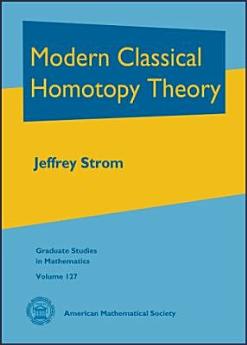Modern Classical Homotopy Theory
Jeffrey Strom
ต.ค. 2011 · American Mathematical Soc.
eBook
835
หน้า
reportคะแนนและรีวิวไม่ได้รับการตรวจสอบยืนยัน ดูข้อมูลเพิ่มเติม
เกี่ยวกับ eBook เล่มนี้
The core of classical homotopy theory is a body of ideas and theorems that emerged in the 1950s and was later largely codified in the notion of a model category. This core includes the notions of fibration and cofibration; CW complexes; long fiber and cofiber sequences; loop spaces and suspensions; and so on. Brown's representability theorems show that homology and cohomology are also contained in classical homotopy theory. This text develops classical homotopy theory from a modern point of view, meaning that the exposition is informed by the theory of model categories and that homotopy limits and colimits play central roles. The exposition is guided by the principle that it is generally preferable to prove topological results using topology (rather than algebra). The language and basic theory of homotopy limits and colimits make it possible to penetrate deep into the subject with just the rudiments of algebra. The text does reach advanced territory, including the Steenrod algebra, Bott periodicity, localization, the Exponent Theorem of Cohen, Moore, and Neisendorfer, and Miller's Theorem on the Sullivan Conjecture. Thus the reader is given the tools needed to understand and participate in research at (part of) the current frontier of homotopy theory. Proofs are not provided outright. Rather, they are presented in the form of directed problem sets. To the expert, these read as terse proofs; to novices they are challenges that draw them in and help them to thoroughly understand the arguments.
ให้คะแนน eBook นี้
แสดงความเห็นของคุณให้เรารับรู้
ข้อมูลในการอ่าน
สมาร์ทโฟนและแท็บเล็ต
ติดตั้งแอป Google Play Books สำหรับ Android และ iPad/iPhone แอปจะซิงค์โดยอัตโนมัติกับบัญชีของคุณ และช่วยให้คุณอ่านแบบออนไลน์หรือออฟไลน์ได้ทุกที่
แล็ปท็อปและคอมพิวเตอร์
คุณฟังหนังสือเสียงที่ซื้อจาก Google Play โดยใช้เว็บเบราว์เซอร์ในคอมพิวเตอร์ได้
eReader และอุปกรณ์อื่นๆ
หากต้องการอ่านบนอุปกรณ์ e-ink เช่น Kobo eReader คุณจะต้องดาวน์โหลดและโอนไฟล์ไปยังอุปกรณ์ของคุณ โปรดทำตามวิธีการอย่างละเอียดในศูนย์ช่วยเหลือเพื่อโอนไฟล์ไปยัง eReader ที่รองรับ




